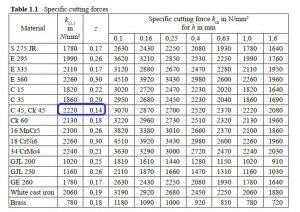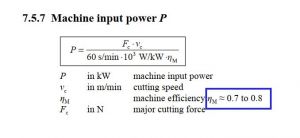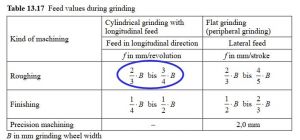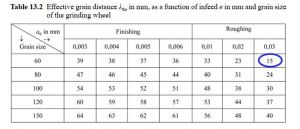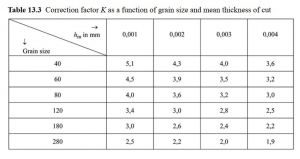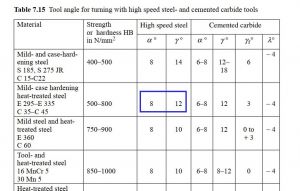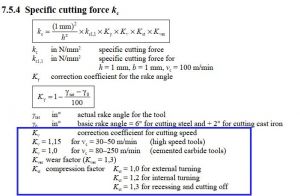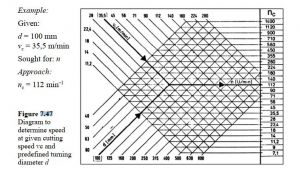Difference between revisions of "Talk:Cylindrical Grinding machine"
Inddigital (talk | contribs) ((by SublimeText.Mediawiker)) |
Inddigital (talk | contribs) ((by SublimeText.Mediawiker)) |
||
| Line 365: | Line 365: | ||
# Fundamentals of Modern Manufacturing: Materials, Processes, and Systems, Fourth Edition, JOHN WILEY & SONS, INC., 2010. | # Fundamentals of Modern Manufacturing: Materials, Processes, and Systems, Fourth Edition, JOHN WILEY & SONS, INC., 2010. | ||
# [https://www.theengineerspost.com/lathe-machine-formula/ CUTTING SPEED, FEED, DEPTH OF CUT, MACHINING TIME IN LATHE MACHINE] Retrieved February 01, 2023. | # [https://www.theengineerspost.com/lathe-machine-formula/ CUTTING SPEED, FEED, DEPTH OF CUT, MACHINING TIME IN LATHE MACHINE] Retrieved February 01, 2023. | ||
# You can see a spreadsheet at [https://en.smath.com/cloud/worksheet/ | # You can see a spreadsheet at [https://en.smath.com/cloud/worksheet/375caGM6 this link] | ||
Revision as of 05:16, 4 February 2023
Project development - Comparative study between grinding and turning processes - Calculations -- Inddigital (talk) 20:06, 01 February 2023 (CET)
Below are the deductions that were made to obtain the results shown on the main page
- Initial data
D1p = 38 mm |
; | D2p = 25 mm |
; | Lp = 100 mm |
; |
D1p + D2p
Dmp = ───────── = 31.5 mm
2
|
; |
D1p - D2p
prt = ───────── = 6.5 mm
2
|
- Where: D1p: Initial diameter of the piece, D2p: Final diameter of the piece, Lp: Piece length, Dmp: Average diameter of the piece, prt: Total depth removed from the piece
- Material to be processed: Steel C45
kc11 = 2220 N/mm2 |
; | z = 0.14 |
; | ηm = 0.7 |
Where: kc11: Specific cutting force, z: material constant, ηm: machine efficiency
These values are obtained from the following sources[1]:
- Grinding process
- Characteristics of the tool used
Cd = 11 USD |
; | Ded = 152.4 mm |
; | Did = 50 mm |
; | Lr = 25 mm |
; | Ded + Did
Dmr = ───────── = 101.2 mm
2
|
Where: Cd: Cost of an abrasive wheel, Ded: Abrasive wheel outside diameter, Did: Internal diameter of abrasive wheel (useful), Abrasive wheel thickness, Dmr: Median diameter of abrasive wheel. For these measurements, a commercial wheel was taken as a reference.
- Machining parameters
vr = 30 m/s |
; | vpr = 0.22 m/s |
; | q = vr / vpr = 136 |
; | fr = 17.5 mm/rev |
; | dr = 0.03 mm |
2 ⋅ vr
nr = ────── = 5662 rpm
Dmr
|
; | 2 ⋅ vpr
npzr = ─────── = 133 rpm
Dmp
|
Where: vr: Abrasive wheel speed, vpr: Speed of the piece in grinding, q: velocity ratio; fr: Feed in grinding, dr: Depth of pass in grinding, nr: Rotational speed of abrasive wheel, npzr: Rotational speed of the piece in grinding
Sources[1]:
- Performance
2 ⋅ (Lp + Lr)
t1pr = ───────────── = 6.4 s
fr ⋅ npzr
|
; | Npr = prt / dr = 23 min |
; | tppr = t1pr ⋅ Npr = 23 min |
; | Npsr = 1 week / tppr = 434 pieces/week |
Where: t1pr: Time of one pass in grinding, Npr: Number of passes in grinding, tppr: Time per piece in grinding, Npsr: Weekly production in grinding.
- Tooling cost
GR = 100 |
; | 2 2
Ded - Did Lr
Npd = GR ⋅ ─────────── ⋅ ── = 632 pieces/wheel
2 2 Lp
D1p - D2p
|
; | 1000
Cmpr = ──── ⋅ Cd = 17 USD
Npd
|
Where: GR: Grinding volume ratio, Npd: Quantity of pieces per abrasive wheel, Cmpr: Cost of abrasive wheels to make 1000 pieces
Sources[2]:
- Mechanical load
λke = 9.66 mm |
; | λke ___________________
hm = ─── ⋅ ╲╱dr ⋅ (1/Dmr + 1/Dmp) = 0.0025mm
q
|
; | K = 3.8691 |
z kc = (1mm/hm) ⋅ kc11 ⋅ K = 19869 N-mm2 |
; | b = 0.7 ⋅ Lr = 17.5 mm |
; | Ftr = b ⋅ hm ⋅ kc = 870 N |
Where: λke: Effective grain distance, hm: Mean thickness of cut, K: Correction factor for grain size, kc: Sspecific cutting force, b: Effective grinding width, Ftr: Cutting force for grinding
Sources[1]:
___________________
360° ╱ dr
φ = ──── ⋅ ╱ ─────────────────── = 0.96°
π ╲╱ Dmr ⋅ (1 + Dmr/Dmp)
|
; | Dmr ⋅ π ⋅ φ
ze = ─────────── = 0.0879
λke ⋅ 360°
|
; | Ftr ⋅ ze ⋅ vr
Potr = ───────────── = 4.39hp
ηm
|
Potr
Tr = ──── = 5.53 N-m
nr
|
; | Ftr ⋅ Dmp
Ttr = ───────── = 13.7 N-m
2
|
; | Pottr = Ttr ⋅ npzr = 0.25 hp |
Where: φ: Angle of approach, ze: Number of cutting edges in contact, Potr: Absorbed power in grinding, Tr: Grinding torque, Ttr: Piece torque, Potr: Absorbed power in piece
- Turning process
- Characteristics of the tool used
Cc = 25 USD |
; | Naf = 10 |
; | vuc = 50 min |
Where: Cc Cost of a cutting tool, Naf: Number of sharps per tool, vuc: Lifespan of a sharp tool. For these data, a commercial cutting tool was taken as a reference.
- Machining parameters
vt = 16 m/min |
; | ft = 0.5 mm/rev |
; | dt = 1 mm |
; | 2 ⋅ vt
nt = ────── = 134 rpm
D1p
|
Where: vt: Cutting speed in turning, ft: Feed in turning, dt: Depth of pass in turning, nt: Rotational speed in turning
Sources[3]:
- Performance
Lp
t1pt = ─────── = 89 s
ft ⋅ nt
|
; | Npt = prt / dt = 7 |
; | tppt = t1pt ⋅ Npt = 10 min |
; | Npst = 1 week / tppt = 1039 pieces/week |
Where: t1pt: Time of one pass in turning, Npt: Number of passes in turning, tppt: Time per piece in turning, Npst: Weekly production in turning.
- Tooling cost
vuc
Npc = ──── ⋅ Naf = 51
tppt
|
; | 1000
Cmpt = ──── ⋅ Cc = 485 USD
Npc
|
Where: Npc: Number of pieces per curring tool, Cmpt: Cost of tools to make 1000 pieces
- Mechanical load
κ = 70° |
; | γ = 12° |
; | α = 6° |
; | h = ft ⋅ sin(κ) = 0.0748 mm |
; | Ac = dt ⋅ ft ⋅ rev = 0.5 mm2 |
; | γ - α
kγ = 1 - ───── = 0.999
100
|
Kv = 1.15 |
; | Kst = 1 |
; | Kver = 1.3 |
; | z kc = (1mm / h) ⋅ kc11 ⋅ kγ ⋅ Kv ⋅ Kst ⋅ Kver = 4767 N/mm2 |
; | Ftt = Ac ⋅ kc = 2383 N |
nt2 = 140 rpm |
; | vt2 = nt2 ⋅ D1p = 33.4 m/min |
; | Ftt ⋅ vt2
Pott = ───────── = 2.54 hp
ηm
|
; | Pott
Tt = ──── = 129 N-m
nt2
|
Where: κ: cutting-edge angle, γ: Rake angle, α: Basic rake angle, h: Thickness of cut, Ac: Sectional area of chip, kγ: Rake coefficient, Kv: Speed coefficient, Kst: compression factor, Kver: wear factor, kc: Specific cutting force, Ftt: Cutting force, nt2: Standard speed, vt2: Real cutting speed, Pott: Input power in turning, Tt: Turning torque
Sources[1]:
Notes
- Applied Machining Technology, Eighth Edition, Springer, 2008.
- Fundamentals of Modern Manufacturing: Materials, Processes, and Systems, Fourth Edition, JOHN WILEY & SONS, INC., 2010.
- CUTTING SPEED, FEED, DEPTH OF CUT, MACHINING TIME IN LATHE MACHINE Retrieved February 01, 2023.
- You can see a spreadsheet at this link

